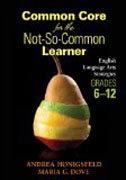
Common Core for the Not-So-Common Learner, Grades 6-12
Honigsfeld, Andrea M.
Dove, Maria G.
The implementation of the Common Core standards is already in full-swing in many of the US public schools. Educators must be trained in how to teach to the new standards for ELA and mathematics, which were designed to be more rigorous and to better prepare students for college and the workplace. For teachers who work with the millions of English learners, the shift to the common standards is even more daunting. This reader-friendly book (and its companion volume for K-5 educators) provides clear guidance on how to make the standards accessible to ELLs and other at-risk learners. The book is grounded in the four ELA strands and the authors offer clear explanations of the expectations of the CCSS as well as a range of essential instructional strategies educators will need to implement when they work with the not so common learner. INDICE: Chapter 1. Introduction Who Are Our Not So Common Learners? The Standards Movement Common Core Advances Application of the Common Core to Address Individual Differences Student Diversity and Teacher Challenges What Is Not Covered In The Common Core Document Focus on Research-Based Strategies to Address Learning NeedsChapter 2. Strategies for Academic Language Development Why Diverse Adolescent Learners Need Explicit Instruction in Academic Language? Core Language and Vocabulary Strategies Conventions of Standard English Knowledge and Application of Language Vocabulary Acquisition and Use Anticipated Outcomes Instructional Challenges Promising Classroom Practices Common Core Standards—(Un)Common Reflection Questions Key ResourcesChapter 3. Reading Strategies for Literature Why Teaching Diverse Adolescent Learners Reading Strategies Promotes Comprehension of Literary Texts Core Reading Strategies Key Ideas and Details Craft and Structure Integration of Knowledge and Ideas Range of Reading and Level of Text Complexity Anticipated Outcomes Instructional Challenges Promising Classroom Practices Common Core Standards—(Un)Common Reflection Questions Key ResourcesChapter 4. Reading Strategies for Informational Texts Why Teaching Diverse Adolescent Learners Reading Strategies Promotes Comprehension of Informational Texts Core Informational Reading Strategies Key Ideas and Details Craft and Structure Integration of Knowledge and Ideas Range of Reading and Level of Text Complexity Anticipated Outcomes Instructional Challenges Promising Classroom Practices Common Core Standards—(Un)Common Reflection Questions Key ResourcesChapter 5. Writing Strategies Why Scaffolding and Explicit Skills Instruction Improves the Writing of Diverse Adolescent Learners Core Writing Strategies Text Types and Purposes Production and Distribution of Writing Research to Build and Present Knowledge Range of Writing Anticipated Outcomes Instructional Challenges Promising Classroom Practices Common Core Standards—(Un)Common Reflection Questions Key ResourcesChapter 6. Speaking and Listening Strategies Why Speaking and Listening Skills Improve the Overall Academic Development of Diverse Adolescent Learners Core Speaking and Listening Strategies Comprehension and Collaboration Presentation of Knowledge and Ideas Anticipated Outcomes Instructional Challenges Promising Classroom Practices Common Core Standards—(Un)Common Reflection Questions Key ResourcesChapter 7. Key to Successful Implementation: Collaborative Strategies Why Collaborative Practices Help Meet the Common Core Core Collaborative Practices Instructional Curriculum mapping and alignment Joint instructional planning Parallel teaching Co-developing instructional materials Collaborative assessment Co-teaching Noninstructional Joint professional development Teacher research Joint parent-teacher conferences and report card writing Planning, facilitating, and participating in extracurricular activities Anticipated Outcomes Challenges Common Core Collaborations—(Un)Common Reflection Questions Key Resources
- ISBN: 978-1-4522-5781-5
- Editorial: Corwin
- Encuadernacion: Rústica
- Páginas: 280
- Fecha Publicación: 25/09/2013
- Nº Volúmenes: 1
- Idioma:
